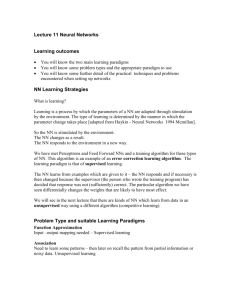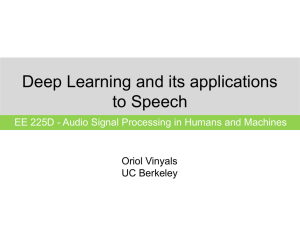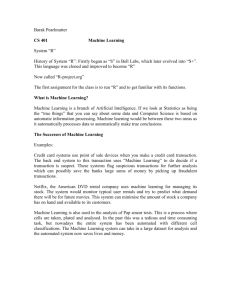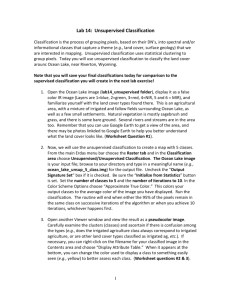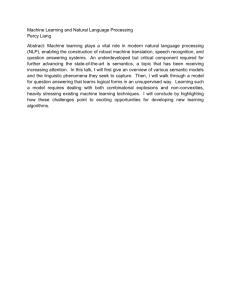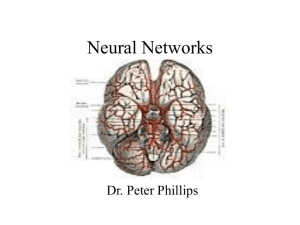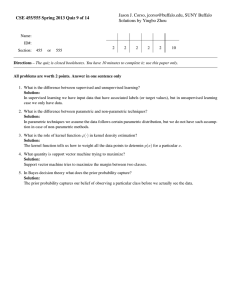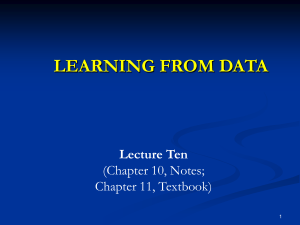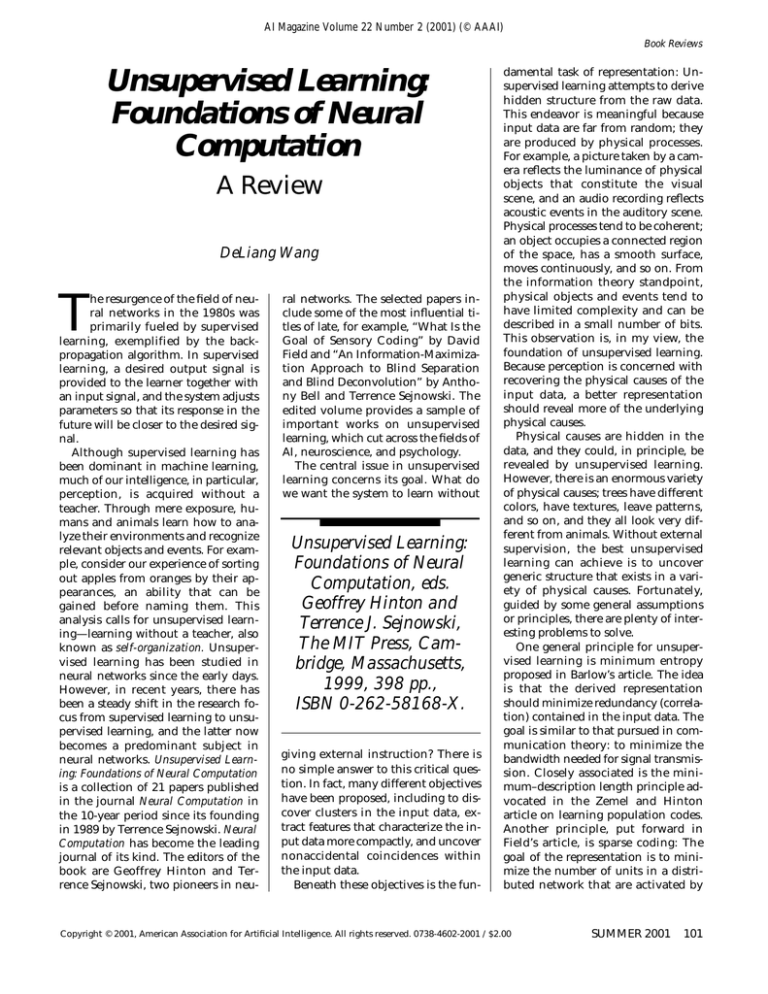
AI Magazine Volume 22 Number 2 (2001) (© AAAI)
Book Reviews
Unsupervised Learning:
Foundations of Neural
Computation
A Review
DeLiang Wang
T
he resurgence of the field of neural networks in the 1980s was
primarily fueled by supervised
learning, exemplified by the backpropagation algorithm. In supervised
learning, a desired output signal is
provided to the learner together with
an input signal, and the system adjusts
parameters so that its response in the
future will be closer to the desired signal.
Although supervised learning has
been dominant in machine learning,
much of our intelligence, in particular,
perception, is acquired without a
teacher. Through mere exposure, humans and animals learn how to analyze their environments and recognize
relevant objects and events. For example, consider our experience of sorting
out apples from oranges by their appearances, an ability that can be
gained before naming them. This
analysis calls for unsupervised learning—learning without a teacher, also
known as self-organization. Unsupervised learning has been studied in
neural networks since the early days.
However, in recent years, there has
been a steady shift in the research focus from supervised learning to unsupervised learning, and the latter now
becomes a predominant subject in
neural networks. Unsupervised Learning: Foundations of Neural Computation
is a collection of 21 papers published
in the journal Neural Computation in
the 10-year period since its founding
in 1989 by Terrence Sejnowski. Neural
Computation has become the leading
journal of its kind. The editors of the
book are Geoffrey Hinton and Terrence Sejnowski, two pioneers in neu-
ral networks. The selected papers include some of the most influential titles of late, for example, “What Is the
Goal of Sensory Coding” by David
Field and “An Information-Maximization Approach to Blind Separation
and Blind Deconvolution” by Anthony Bell and Terrence Sejnowski. The
edited volume provides a sample of
important works on unsupervised
learning, which cut across the fields of
AI, neuroscience, and psychology.
The central issue in unsupervised
learning concerns its goal. What do
we want the system to learn without
Unsupervised Learning:
Foundations of Neural
Computation, eds.
Geoffrey Hinton and
Terrence J. Sejnowski,
The MIT Press, Cambridge, Massachusetts,
1999, 398 pp.,
ISBN 0-262-58168-X.
giving external instruction? There is
no simple answer to this critical question. In fact, many different objectives
have been proposed, including to discover clusters in the input data, extract features that characterize the input data more compactly, and uncover
nonaccidental coincidences within
the input data.
Beneath these objectives is the fun-
damental task of representation: Unsupervised learning attempts to derive
hidden structure from the raw data.
This endeavor is meaningful because
input data are far from random; they
are produced by physical processes.
For example, a picture taken by a camera reflects the luminance of physical
objects that constitute the visual
scene, and an audio recording reflects
acoustic events in the auditory scene.
Physical processes tend to be coherent;
an object occupies a connected region
of the space, has a smooth surface,
moves continuously, and so on. From
the information theory standpoint,
physical objects and events tend to
have limited complexity and can be
described in a small number of bits.
This observation is, in my view, the
foundation of unsupervised learning.
Because perception is concerned with
recovering the physical causes of the
input data, a better representation
should reveal more of the underlying
physical causes.
Physical causes are hidden in the
data, and they could, in principle, be
revealed by unsupervised learning.
However, there is an enormous variety
of physical causes; trees have different
colors, have textures, leave patterns,
and so on, and they all look very different from animals. Without external
supervision, the best unsupervised
learning can achieve is to uncover
generic structure that exists in a variety of physical causes. Fortunately,
guided by some general assumptions
or principles, there are plenty of interesting problems to solve.
One general principle for unsupervised learning is minimum entropy
proposed in Barlow’s article. The idea
is that the derived representation
should minimize redundancy (correlation) contained in the input data. The
goal is similar to that pursued in communication theory: to minimize the
bandwidth needed for signal transmission. Closely associated is the minimum–description length principle advocated in the Zemel and Hinton
article on learning population codes.
Another principle, put forward in
Field’s article, is sparse coding: The
goal of the representation is to minimize the number of units in a distributed network that are activated by
Copyright © 2001, American Association for Artificial Intelligence. All rights reserved. 0738-4602-2001 / $2.00
SUMMER 2001
101
Book Reviews
any given image. In the article, Field
argues systematically for such a representation in the mammalian visual
system. Other general principles include maximizing mutual information
between the input and the output of
the system and deriving mutually independent feature vectors.
In a less obvious way, one can view
unsupervised learning as supervised
learning with no input, treating the
data as the output of the system. The
representation to be derived is then
viewed as a model for the input data.
This is the generative approach embodied in the Helmholtz machine introduced in the article by Dayan et al.
According to this approach, the goal
of unsupervised learning is to model
the probability density of the input
data. The generative approach can be
traced back to the Boltzmann machine
(Ackley, Hinton, and Sejnowski 1985).
Unsupervised learning algorithms
commonly use two techniques: (1) optimization and (2) Hebbian learning.
The previous discussion on the goal of
unsupervised learning makes it clear
that learning algorithms almost invariably boil down to an optimization
problem, whether to minimize entropy or maximize mutual information. The Hebbian learning rule states
that the connection between two neurons is strengthened if they fire at the
same time (Hebb 1949), which is supported by strong biological evidence.
The anti-Hebbian rule, which weakens
the connection when two neurons fire
simultaneously, also proves useful.
The utility of the Hebbian (anti-Hebbian) rule in unsupervised learning
should not come as a surprise because
the Hebbian rule is about correlation
(anticorrelation), the detection of
which is a central task for unsupervised learning.
The method of independent component analysis (ICA), which attempts to
identify statistically independent
causes from their mixtures, has recently generated considerable excitement
in the broad area of signal processing.
The idea of ICA is equivalent to the
minimum entropy principle, and unsupervised learning produces algorithms for deriving independent components through training with
mixture samples (the articles by Bell
102
AI MAGAZINE
and Sejnowski, Amari, and Hyvörinen
and Oja). In the last few years, ICA has
been applied with impressive success
to an array of real-world problems, including medical data analysis (for example, EEG) and the cocktail party
problem for decomposing acoustic
mixtures.
A related success is the development
of model neurons whose response
properties resemble the receptive
fields of simple cells in the mammalian visual cortex. Simple cells possess receptive fields that can be characterized as oriented and spatially
localized bandpass filters, best described by Gabor filters. It is remarkable that such receptive fields can
emerge as a result of applying unsupervised learning to an ensemble of
natural images (as in the Atick and
Redlich article) (Bell and Sejnowski
1997; Olshausen and Field 1996).
These results provide a computational
basis for reasoning about general
strategies used by the brain for sensory
processing.
Most unsupervised learning algorithms are based on statistical estimation of the input data. As pointed out
in the Konen and von der Malsburg article, such algorithms generally suffer
from the problem of combinatorial explosion when dealing with realistically
large patterns. They proposed incorporating structure, specifically the prior
principle of conservation of topological structure, into their self-organization network for symmetry detection
(see also the Gold et al. article). Their
article emphasizes geometric principles, rather than statistical principles,
for unsupervised learning. It is revealing to consider the old Minsky-Papert
connectedness problem (Minsky and
Papert 1969) in this context. This
problem is one of telling connected
patterns from disconnected ones. On a
two-dimensional grid, there are exponentially many connected patterns. In
theory, one could get a multilayer network to learn the connectedness predicate. However, as pointed out by Minsky and Papert (1988), it is practically
infeasible because it requires far too
many training samples and too much
learning time. Not until recently was a
neural network solution found, and
the solution to the problem is based
on a simple architecture with primarily nearest-neighbor coupling and an
oscillatory correlation representation
that labels pixels by synchrony and
desynchrony (Wang 2000). This solution echoes the point of Konen and
von der Malsburg on the importance
of prior structure. From the philosophical point of view, the brain of a newborn possesses genetic knowledge resulting from millions of years of
evolution. Although, in theory, all is
learnable, including connectivity and
representation, computational complexity has to be an important consideration. Hence, future investigation
on unsupervised learning needs to incorporate appropriate prior structure.
In summary, this book is essential
reading for professionals and graduate
students who work on sensory encoding, perceptual processing, and machine learning. It is also a valuable
source for engineers working in the areas of computer vision, speech processing, and communication.
References
Ackley, D. H.; Hinton, G. E.; and Sejnowski,
T. J. 1985. A Learning Algorithm for Boltzmann Machines. Cognitive Science 9(2):
147–169.
Bell, A. J., and Sejnowski, T. J. 1997. The
“Independent Components” of Natural
Scenes Are Edge Filters. Vision Research
37(23): 3327–3338.
Hebb, D. O. 1949. The Organization of Behavior. New York: Wiley.
Minsky, M. L., and Papert, S. A. 1988. Perceptrons. Expanded ed. Cambridge, Mass.:
MIT Press.
Minsky, M. L., and Papert, S. A. 1969. Perceptrons. Cambridge, Mass.: MIT Press.
Olshausen, B. A., and Field, D. J. 1996.
Emergence of Simple-Cell Receptive Field
Properties by Learning a Sparse Code for
Natural Images. Nature 381:607–609.
Wang, D. L. 2000. On Connectedness: A Solution Based on Oscillatory Correlation.
Neural Computation 12:131–139.
DeLiang Wang is an associate professor of
computer and information science and
cognitive science at The Ohio State University. His research interests include neural
networks for perception, neurodynamics,
and computational neuroscience. His email address is dwang@cis.ohio-state.edu.

